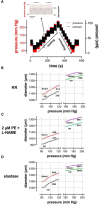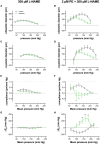Aortic Stiffness Hysteresis in Isolated Mouse Aortic Segments Is Intensified by Contractile Stimuli, Attenuated by Age, and Reversed by Elastin Degradation
- PMID: 34650441
- PMCID: PMC8507434
- DOI: 10.3389/fphys.2021.723972
Aortic Stiffness Hysteresis in Isolated Mouse Aortic Segments Is Intensified by Contractile Stimuli, Attenuated by Age, and Reversed by Elastin Degradation
Abstract
Aim: Cyclic stretch of vascular tissue at any given pressure reveals greater dimensions during unloading than during loading, which determines the cardiac beat-by-beat hysteresis loop on the pressure-diameter/volume relationship. The present study did not focus on hysteresis during a single stretch cycle but investigated whether aortic stiffness determined during continuous stretch at different pressures also displayed hysteresis phenomena. Methods: Aortic segments from C57Bl6 mice were mounted in the Rodent Oscillatory Set-up for Arterial Compliance (ROTSAC), where they were subjected to high frequency (10 Hz) cyclic stretch at alternating loads equivalent to a constant theoretical pulse pressure of 40 mm Hg. Diastolic and systolic diameter, compliance, and the Peterson elastic modulus (Ep), as a measure of aortic stiffness, was determined starting at cyclic stretch between alternating loads corresponding to 40 and 80 mm Hg, at each gradual load increase equivalent to 20 mm Hg, up to loads equivalent to pressures of 220 and 260 mm Hg (loading direction) and then repeated in the downward direction (unloading direction). This was performed in baseline conditions and following contraction by α1 adrenergic stimulation with phenylephrine or by depolarization with high extracellular K+ in aortas of young (5 months), aged (26 months) mice, and in segments treated with elastase. Results: In baseline conditions, diastolic/systolic diameters and compliance for a pulse pressure of 40 mm Hg were larger at any given pressure upon unloading (decreasing pressure) than loading (increasing pressure) of the aortic segments. The pressure-aortic stiffness (Ep) relationship was similar in the loading and unloading directions, and aortic hysteresis was absent. On the other hand, hysteresis was evident after activation of the VSMCs with the α1 adrenergic agonist phenylephrine and with depolarization by high extracellular K+, especially after inhibition of basal NO release with L-NAME. Aortic stiffness was significantly smaller in the unloading than in the loading direction. In comparison with young mice, old-mouse aortic segments also displayed contraction-dependent aortic hysteresis, but hysteresis was shifted to a lower pressure range. Elastase-treated segments showed higher stiffness upon unloading over nearly the whole pressure range. Conclusions: Mouse aortic segments display pressure- and contraction-dependent diameter, compliance, and stiffness hysteresis phenomena, which are modulated by age and VSMC-extracellular matrix interactions. This may have implications for aortic biomechanics in pathophysiological conditions and aging.
Keywords: aging; aortic stiffness; constriction; pressure-dependent hysteresis; viscosity.
Copyright © 2021 De Moudt, Leloup and Fransen.
Conflict of interest statement
The authors declare that the research was conducted in the absence of any commercial or financial relationships that could be construed as a potential conflict of interest.
Figures










Similar articles
-
Cyclic Stretch Alters Vascular Reactivity of Mouse Aortic Segments.Front Physiol. 2017 Oct 30;8:858. doi: 10.3389/fphys.2017.00858. eCollection 2017. Front Physiol. 2017. PMID: 29163203 Free PMC article.
-
A novel set-up for the ex vivo analysis of mechanical properties of mouse aortic segments stretched at physiological pressure and frequency.J Physiol. 2016 Nov 1;594(21):6105-6115. doi: 10.1113/JP272623. Epub 2016 Aug 2. J Physiol. 2016. PMID: 27256450 Free PMC article.
-
Basal Vascular Smooth Muscle Cell Tone in eNOS Knockout Mice Can Be Reversed by Cyclic Stretch and Is Independent of Age.Front Physiol. 2022 Apr 28;13:882527. doi: 10.3389/fphys.2022.882527. eCollection 2022. Front Physiol. 2022. PMID: 35574444 Free PMC article.
-
Left ventricular performance is closely related to the physical properties of the arterial system: Landmark clinical investigations in the 1970s and 1980s.Arch Cardiovasc Dis. 2014 Oct;107(10):554-62. doi: 10.1016/j.acvd.2014.08.001. Epub 2014 Oct 8. Arch Cardiovasc Dis. 2014. PMID: 25304173 Review.
-
Clinical measurement of arterial stiffness obtained from noninvasive pressure waveforms.Am J Hypertens. 2005 Jan;18(1 Pt 2):3S-10S. doi: 10.1016/j.amjhyper.2004.10.009. Am J Hypertens. 2005. PMID: 15683725 Review.
Cited by
-
Acute vascular and cardiac effects of lenvatinib in mice.Cardiooncology. 2025 Feb 11;11(1):14. doi: 10.1186/s40959-025-00307-8. Cardiooncology. 2025. PMID: 39934897 Free PMC article.
-
Increasing pulse pressure ex vivo, mimicking acute physical exercise, induces smooth muscle cell-mediated de-stiffening of murine aortic segments.Commun Biol. 2023 Nov 9;6(1):1137. doi: 10.1038/s42003-023-05530-6. Commun Biol. 2023. PMID: 37945735 Free PMC article.
-
The alteration of the structure and macroscopic mechanical response of porcine patellar tendon by elastase digestion.Front Bioeng Biotechnol. 2024 Apr 17;12:1374352. doi: 10.3389/fbioe.2024.1374352. eCollection 2024. Front Bioeng Biotechnol. 2024. PMID: 38694621 Free PMC article.
References
LinkOut - more resources
Full Text Sources

